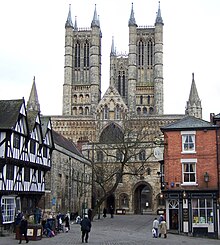Lincoln Cathedral
| Lincoln Cathedral | |
|---|---|
| Cathedral Church of the Blessed Virgin Mary of Lincoln | |
 |
|
| Coordinates: 53°14′04″N 0°32′10″W / 53.23444°N 0.53611°W | |
| Location | Lincoln, Lincolnshire |
| Country | England |
| Denomination | Church of England |
| Tradition | Anglo-Catholic |
| Website | www |
| History | |
| Consecrated | 11 May 1092 |
| Architecture | |
| Style | Gothic |
| Years built | 1185–1311 |
| Groundbreaking | 1088 |
| Specifications | |
| Length | 143.3 metres (470 ft) |
| Number of towers | 3 |
| Tower height | 83 metres (272 ft) (crossing) |
| Number of spires | 3 (now lost) |
| Spire height | 160 metres (520 ft) (crossing tower) |
| Bells | 20 (spread over three towers) |
| Administration | |
| Diocese | Lincoln (since 1072) |
| Province | Canterbury |
| Clergy | |
| Dean | Christine Wilson |
| Subdean | John Patrick |
| Chancellor | Mark Hocknull |
| Archdeacon | Gavin Kirk |
| Laity | |
| Director of music | Aric Prentice |
| Organist(s) | Jeffery Makinson |
Lincoln Cathedral or the Cathedral Church of the Blessed Virgin Mary of Lincoln, and sometimes St. Mary's Cathedral in Lincoln, England is the seat of the Anglican bishop. Building commenced in 1088 and continued in several phases throughout the medieval period. It was the tallest building in the world for 238 years (1311–1549), and the first building to hold that title after the Great Pyramid of Giza. The central spire collapsed in 1549 and was not rebuilt. The cathedral is the third largest in Britain (in floor area) after St Paul's and York Minster, being 484 by 271 feet (148 by 83 m). It is highly regarded by architectural scholars; the eminent Victorian writer John Ruskin declared: "I have always held... that the cathedral of Lincoln is out and out the most precious piece of architecture in the British Isles and roughly speaking worth any two other cathedrals we have."
Remigius de Fécamp, the first Bishop of Lincoln, moved the episcopal seat (cathedra) there "some time between 1072 and 1092" About this, James Essex writes that "Remigius ... laid the foundations of his Cathedral in 1088" and "it is probable that he, being a Norman, employed Norman masons to superintend the building ... though he could not complete the whole before his death." Before that, writes B. Winkles, "It is well known that Remigius appropriated the parish church of St Mary Magdalene in Lincoln, although it is not known what use he made of it."
Up until then St. Mary's Church in Stow was considered to be the "mother church" of Lincolnshire (although it was not a cathedral, because the seat of the diocese was at Dorchester Abbey in Dorchester-on-Thames, Oxfordshire). However, Lincoln was more central to a diocese that stretched from the Thames to the Humber.
...
Wikipedia

